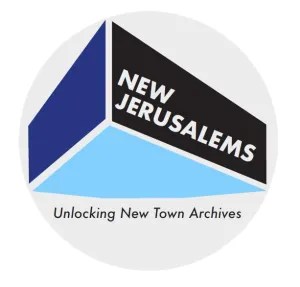By Alice Millard, project archivist
With funding granted by the Wellcome Trust, nine organisations across England, Wales, and Ireland have embarked upon a major project to catalogue and make accessible the archives of 11 post-war new towns. These new towns are Basildon, Bracknell, Crawley, Cwmbran, Newton Aycliffe, Peterlee, Redditch, Runcorn, Shannon, Stevenage and Warrington.

WSRO is the home to the archive of the Crawley Development Corporation (the organisation that built the New Town), but the scale of the collection means that not been possible to catalogue it. This project has enabled WSRO to fund an archivist (me) for two years to do so. I am currently just ten weeks into this substantial task, yet I am already discovering fascinating records and photographs documenting the rise of Crawley New Town (CNT).
What is a ‘new town’?
During the Second World War, London in particular suffered substantial losses in housing due to bombing. This was an additional problem on top of the existing issue of sub-standard accommodation that had rapidly developed in the nineteenth century. By 1944, the government had realised this was the time to address this escalating crisis.
A man called [Sir] Patrick Abercrombie – a town planner – developed the Greater London Plan in 1944. This plan proposed the construction of eight new towns within 50 miles of London. Residents of London would be able to move away from the city, thereby reducing the strain on metropolitan resources, and enabling them to set up new lives with better employment and more suitable housing in these new towns.
In 1945, the New Towns Commission was established by Clement Atlee’s government. Their work developed the Great London Plan further and in 1946 the New Towns Act was passed, designating 10 areas for new towns over the following four years. Stevenage in Hertfordshire was the very first to be designated in November 1946, with Crawley following shortly after in January 1947.

The Central Office of Information made this 1948 public information film. Whilst it doesn’t refer to the New Towns Act specifically (perhaps to make the idea feel more ‘organic’), it outlines the vision the government had for new towns:
The New Towns Act marked the beginning of an immense period of town planning across the country. So great was the ambition that it is difficult to imagine such a proliferation of communities happening again. Today, new towns are sometimes seen as bygone utopian ideals or tired concrete jungles, and some have certainly stood the test of time more than others.
A popular criticism is that they lack the character that smaller towns have when left to grow ‘organically’. The architects developing and implementing master plans for the new towns were inspired in part by the modernist movement in Europe. They embraced wide open spaces, functionality and new materials like concrete. This resulted in towns whose buildings resembled each other and were a world away from the mismatched charm of traditional town centres.

Yet the new towns were a vision of exemplary living standards, and for many people who moved to them that was indeed the case. Each new town had a master plan which set out carefully considered spaces for housing, schools, shops, factories, and amenities. Families with young children were particularly catered for with pedestrianised areas in town centres and green spaces for play. Healthy living was at the forefront of everyone’s minds, exemplified in the public information film above which contrasts the green open spaces of new towns with the overcrowding, smog and pollution of London.

The CNT archive is full of working documents and surveys conducted by the research department of the Corporation. They focus on issues such as sufficient provision of shops to population numbers and what elements are essential to a child’s adventure playground. These records show a level of detail which went far beyond simply building better homes; this was expert town planning intended to make life better for residents.